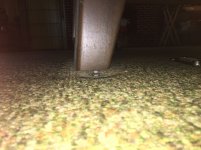I have a 1974 Brunswick Windsor table that is not quite level on one side, balls curve away from the pockets at slow roll. Each leg has a threaded bolt with two nuts. The bottom nut is thin, the one above is a little thicker. These nuts are not snug, there is about a 1/8" gap between them. Two nuts is usually a locking type of arrangement?
Which one should I turn and iwhich way if I want that leg to be lower, clockwise or counter-clockwise? The one on the top or one on the bottom?
So far, my attempts are not doing anything. I suppose the middle of the table could also be a bit low on that side?
EDIT: Photo is in next post.
Which one should I turn and iwhich way if I want that leg to be lower, clockwise or counter-clockwise? The one on the top or one on the bottom?
So far, my attempts are not doing anything. I suppose the middle of the table could also be a bit low on that side?
EDIT: Photo is in next post.
Last edited:
